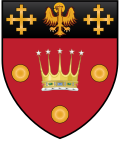Portal:University of Oxford
| Main page | Indices | Projects |
The University of Oxford portal
The University of Oxford is a collegiate research university in Oxford, England. There is evidence of teaching as early as 1096, making it the oldest university in the English-speaking world and the world's second-oldest university in continuous operation. It grew rapidly from 1167, when Henry II banned English students from attending the University of Paris. After disputes between students and Oxford townsfolk in 1209, some academics fled north-east to Cambridge where they established what became the University of Cambridge. The two English ancient universities share many common features and are jointly referred to as Oxbridge.
The University of Oxford is made up of thirty-nine semi-autonomous constituent colleges, four permanent private halls, and a range of academic departments which are organised into four divisions. Each college is a self-governing institution within the university, controlling its own membership and having its own internal structure and activities. All students are members of a college.
It does not have a main campus, but its buildings and facilities are scattered throughout the city centre. Undergraduate teaching at Oxford consists of lectures, small-group tutorials at the colleges and halls, seminars, laboratory work and occasionally further tutorials provided by the central university faculties and departments. Postgraduate teaching is provided in a predominantly centralised fashion.
Oxford operates the Ashmolean Museum, the world's oldest university museum; Oxford University Press, the largest university press in the world; and the largest academic library system nationwide. In the fiscal year ending 31 July 2023, the university had a total consolidated income of £2.92 billion, of which £789 million was from research grants and contracts.
Oxford has educated a wide range of notable alumni, including 30 prime ministers of the United Kingdom and many heads of state and government around the world. 73 Nobel Prize laureates, 4 Fields Medalists, and 6 Turing Award winners have matriculated, worked, or held visiting fellowships at the University of Oxford, while its alumni have won 160 Olympic medals. Oxford is the home of numerous scholarships, including the Rhodes Scholarship, one of the oldest international graduate scholarship programmes. (Full article...)
Selected article
Bodley's Librarian is the head of the Bodleian Library, the main library at the University of Oxford. Both are named after the founder, Sir Thomas Bodley (pictured). The university's library was established in about 1320 but had declined by the end of the 16th century, so in 1598 Bodley offered to restore it. The first librarian, Thomas James, was selected in 1599, and the Bodleian opened in 1602. Bodley wanted the librarian to be diligent, a linguist, unmarried, and not a parish priest, although James persuaded him to dispense with the last two requirements. In all, 25 people have served as Bodley's Librarian, some less well than others: John Price (who held the post from 1768 to 1813) was accused of "a regular and constant neglect of his duty". The first woman, and the first foreign librarian, to run the Bodleian was Sarah Thomas (2007–13). The current librarian is Richard Ovenden. (Full article...)
Selected biography
Selected college or hall
St Stephen's House is a theological college and one of the Permanent Private Halls (PPHs) of the University of Oxford. Unlike the colleges, which are run by their Fellows, PPHs are run by an outside institution – in the case of St Stephen's, the Church of England. It was founded in 1876 by Edward King, Bishop of Lincoln and one of the leading figures in the Tractarian movement, and became a PPH in 2003. It was originally located in the centre of Oxford on the site where the New Bodleian Library now stands, but moved soon afterwards to North Oxford. In 1980, it acquired a site in Iffley Road, East Oxford, that had been vacated by the Society of St. John the Evangelist. The current buildings contain the church of St John the Evangelist, designed by G F Bodley; accommodation is provided on site for married and single students. Part of the Anglo-Catholic tradition of the Church of England, it trains candidates for ordination and accepts other students for qualifications in Theology or Education. Alumni include David Hope (Archbishop of York), Glyn Simon (Archbishop of Wales), Jeffrey John (Dean of St Alban's) and Trevor Mwamba (Bishop of Botswana). (Full article...)
Selected image

Did you know
Articles from Wikipedia's "Did You Know" archives about the university and people associated with it:
- ... that Charles Ranken (pictured) and Lord Randolph Churchill founded the Oxford University Chess Club in April 1869, with Ranken becoming its first president?
- ... that John Verney became a Member of Parliament to gain contacts to help him in his career as a barrister?
- ... that W. G. Collingwood, John Ruskin's secretary and assistant, was a noted scholar of Norse history and art?
- ... that Rabbi Asher Lopatin supported a Chicago ban on foie gras on the grounds that the Torah prohibits cruelty to animals, noting that "chopped liver is good, but foie gras is bad"?
- ... that Alexander Wilkinson managed to play 74 more first-class cricket matches despite an injured hand that almost had to be amputated after World War I?
Selected quotation
Selected panorama
Wikimedia
The following Wikimedia Foundation sister projects provide more on this subject:
-
Commons
Free media repository -
Wikibooks
Free textbooks and manuals -
Wikidata
Free knowledge base -
Wikinews
Free-content news -
Wikiquote
Collection of quotations -
Wikisource
Free-content library -
Wikiversity
Free learning tools -
Wikivoyage
Free travel guide -
Wiktionary
Dictionary and thesaurus















